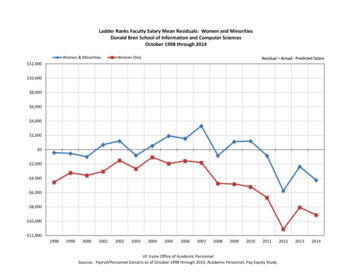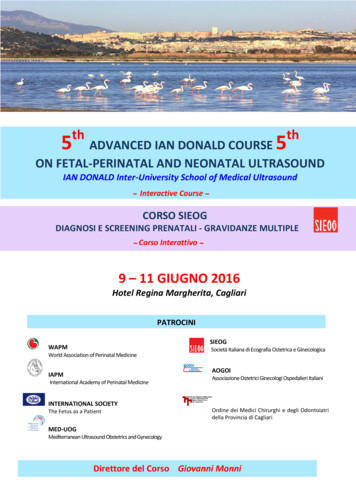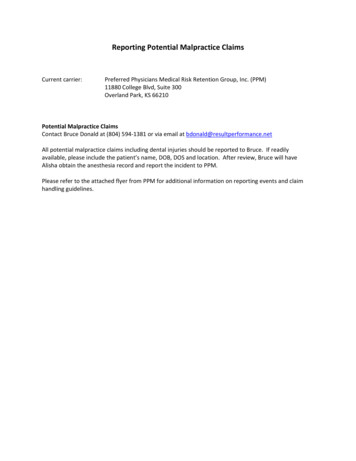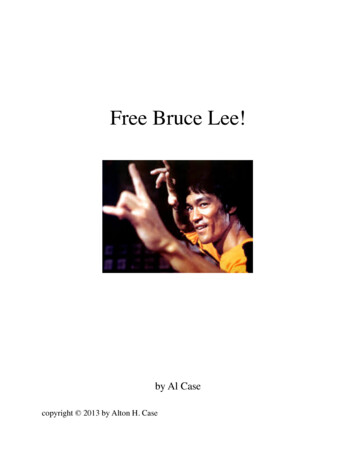
Transcription
“This is the standard of care, the ultimate, practical arbitrator.”—Donald A. Bruce, Geosystems LPMichael Tomlinson’s classic and widely used reference has been updated to providecomprehensive references to the new codes and standards now essential for the design andconstruction of piled foundations. Emphasis is placed on the well-established theoreticaland empirical calculation methods which are amenable to the application of basic computersoftware for pile design. The worked examples incorporate the Eurocode limit state principlesand, where applicable, deal with permissible stress design, drawing on the UK NationalAnnex and currently active British Standards. New sections include the construction of micropiles and CFA piles, pile-soilinteraction, verification of pile materials, piling for integral bridge abutments, use ofpolymer stabilising fluids, and more Includes calculations of the resistance of piles to compressive loads, pile groupsunder compressive loading, piled foundations for resisting uplift and lateral loading,and the structural design of piles and pile groups Covers marine structures, durability of piled foundations, ground investigations,and pile testing and miscellaneous problems such as machinery foundations, under pinning, mining subsidence areas, geothermal piles, and unexploded ordnanceIt features case studies and detailed examples from around the world which demonstratehow piling problems are tackled and solved, and it comments on the essential contract termsand conditions for undertaking work. All is backed-up with relevant published information. Itserves as a guide for practising geotechnical engineers and engineering geologists, and asa resource for piling contractors and graduate students studying geotechnical engineering.an informa businesswww.crcpress.com6000 Broken Sound Parkway, NWSuite 300, Boca Raton, FL 33487711 Third AvenueNew York, NY 100172 Park Square, Milton ParkAbingdon, Oxon OX14 4RN, UKK20573ISBN: 978-1-4665-9263-6SixthEditionJohn Woodward and the late Michael Tomlinson were colleagues for many years working fora major international civil engineering contractor, undertaking geotechnical investigations,foundation design and construction, materials testing and specialist contracting services.They worked on major projects worldwide such as docks, harbours, petroleum productionand refining facilities, onshore and offshore, industrial structures and multistorey buildings.They have also been independently engaged as geotechnical consultants to the constructionindustry preparing foundation designs, legal reports and contractual advice.Pile Design andConstruction Practice“The book gives a comprehensive overview of the piling techniques in common use, theiradvantages and disadvantages. This information gives a sound basis for the selectionof a given technique. Design of piles to Eurocode 7 is well described and all the generalpile installation methods covered.”—Hilary Skinner, Donaldson Associates Ltd.TomlinsonWoodwardCivil EngineeringPile Design andConstruction PracticeSixth EditionMichael Tomlinson and John Woodward900009 781466 592636w w w.sponpress.comK20573 mech rev.indd 1A SPON PRESS BOOK8/28/14 9:24 AM
Pile Design andConstruction PracticeSixth Edition
Pile Design andConstruction PracticeSixth EditionMichael Tomlinson and John WoodwardA SPON PRESS BOOK
The publishers and authors disclaim any liability in whole or part, arising from information contained in this book. Thereader is advised to consult with an appropriate licensed professional before taking action or making any interpretationof the material in this book.CRC PressTaylor & Francis Group6000 Broken Sound Parkway NW, Suite 300Boca Raton, FL 33487-2742 2015 by The estate of Michael J Tomlinson and John C WoodwardCRC Press is an imprint of Taylor & Francis Group, an Informa businessNo claim to original U.S. Government worksVersion Date: 20140811International Standard Book Number-13: 978-1-4665-9264-3 (eBook - PDF)This book contains information obtained from authentic and highly regarded sources. Reasonable efforts have beenmade to publish reliable data and information, but the author and publisher cannot assume responsibility for the validity of all materials or the consequences of their use. The authors and publishers have attempted to trace the copyrightholders of all material reproduced in this publication and apologize to copyright holders if permission to publish in thisform has not been obtained. If any copyright material has not been acknowledged please write and let us know so we mayrectify in any future reprint.Except as permitted under U.S. Copyright Law, no part of this book may be reprinted, reproduced, transmitted, or utilized in any form by any electronic, mechanical, or other means, now known or hereafter invented, including photocopying, microfilming, and recording, or in any information storage or retrieval system, without written permission from thepublishers.For permission to photocopy or use material electronically from this work, please access www.copyright.com (http://www.copyright.com/) or contact the Copyright Clearance Center, Inc. (CCC), 222 Rosewood Drive, Danvers, MA 01923,978-750-8400. CCC is a not-for-profit organization that provides licenses and registration for a variety of users. Fororganizations that have been granted a photocopy license by the CCC, a separate system of payment has been arranged.Trademark Notice: Product or corporate names may be trademarks or registered trademarks, and are used only foridentification and explanation without intent to infringe.Visit the Taylor & Francis Web site athttp://www.taylorandfrancis.comand the CRC Press Web site athttp://www.crcpress.com
ContentsPreface to the sixth editionPreface to the first edition1 General principles and practicesxiiixix11.1 Function of piles 11.2 History 11.3 Calculations of load-carrying capacity 21.4 Dynamic piling formulae 41.5 Introduction of Eurocodes and other standards 51.6 Responsibilities of employer and contractor 8References 102 Types of pile2.12.22.311Classification of piles 112.1.1 Large-displacement piles (driven types) 112.1.2 Large-displacement piles (driven and cast-in-place types) 122.1.3 Small-displacement piles 122.1.4 Replacement piles 122.1.5 Composite piles 122.1.6 Minipiles and micropiles 122.1.7 Selection of pile type 12Driven displacement piles 152.2.1 Timber piles 152.2.2 Precast concrete piles 192.2.3 Jointed precast concrete piles 272.2.4 Steel piles 302.2.5 Shoes for steel piles 402.2.6 Yield stresses for steel piles 41Driven and cast-in-place displacement piles 442.3.1 General 442.3.2 Withdrawable-tube types 442.3.3 Shell types 47v
viContents2.3.4 Stresses on driven and cast-in-place piles 482.3.5 Rotary displacement auger piles 492.3.6 Helical plate screw piles 512.3.7 Vibrated concrete columns 512.4 Replacement piles 522.4.1 General 522.4.2 Bored and cast-in-place piles 522.4.3 Continuous flight auger piles 552.4.4 Drilled-in tubular piles 582.5 Composite piles 582.6 Minipiles and micropiles 602.6.1 Minipiles 602.6.2 Micropiles 622.7 Pre-packed piles 632.8 Factors governing choice of type of pile 632.8.1 Driven displacement piles 632.8.2 Driven and cast-in-place displacement piles 642.8.3 Bored and cast-in-place replacement piles 652.8.4 Choice of pile materials 65References 663 Piling equipment and methods3.13.23.33.4Equipment for driven piles 703.1.1 Piling frames 703.1.2 Crane-supported leaders 723.1.3 Trestle guides 763.1.4 Piling hammers 773.1.5 Piling vibrators 853.1.6 Selection of type of piling hammer 863.1.7 Noise and vibration control in pile driving 893.1.8 Pile helmets and driving caps 933.1.9 Jetting piles 94Equipment for installing driven and cast-in-place piles 96Equipment for installing bored and cast-in-place piles 983.3.1 Power augers 983.3.2 Boring with casing oscillators 1053.3.3 Continuous flight auger drilling rigs 1053.3.4 Drilling with a kelly 1063.3.5 Reverse-circulation drilling rigs 1073.3.6 Large grab rigs 1103.3.7 Tripod rigs 1103.3.8 Drilling for piles with bentonite slurry and support fluids 1123.3.9 Base and shaft grouting of bored and cast-in-place piles 113Procedure in pile installation 1163.4.1 Driving timber piles 1173.4.2 Driving precast (including prestressed) concrete piles 11769
Contentsvii3.4.33.4.43.4.5Driving steel piles 117Driving and concreting steel shell piles 119Installation of withdrawable-tube typesof driven and cast-in-place piles 1193.4.6 Installation of bored and cast-in-placepiles by power auger equipment 1203.4.7 Installing continuous flight auger piles 1233.4.8 Concreting pile shafts under water 1243.4.9 Installation of bored and cast-in-place piles bygrabbing, vibratory and reverse-circulation rigs 1253.4.10 Installation of bored and cast-in-place piles by tripod rigs 1253.4.11 Installation of raking piles 1253.4.12 Withdrawal of temporary casings 1263.4.13 Positional tolerances 1273.5 Constructing piles in groups 128References 1284 Calculating the resistance of piles to compressive loads4.14.24.34.44.54.6General considerations 1314.1.1 Basic approach to the calculation of pile resistance 1314.1.2 Behaviour of a pile under load 1324.1.3 Determining allowable loads on pilesusing allowable stress methods 1344.1.4 Determining design loads and resistances incompression using the procedure in EurocodeBS EN 1997-1:2004 Geotechnical design 135Calculations for piles in fine-grained soils 1434.2.1 Driven displacement piles 1434.2.2 Driven and cast-in-place displacement piles 1514.2.3 Bored and cast-in-place non-displacement piles 1514.2.4 Time effects on pile resistance in clays 155Piles in coarse-grained soils 1564.3.1 General 1564.3.2 Driven piles in coarse-grained soils 1634.3.3 Piles with open ends driven into coarse-grained soils 1644.3.4 Driven and cast-in-place piles in coarse-grained soils 1654.3.5 Bored and cast-in-place piles in coarse-grained soils 1654.3.6 Use of in situ tests to predict the ultimateresistance of piles in coarse-grained soils 1674.3.7 Tubular steel piles driven to deeppenetration into clays and sands 1714.3.8 Time effects for piles in coarse-grained soils 177Piles in soils intermediate between sands and clays 178Piles in layered fine- and coarse-grained soils 179Settlement of the single pile at the applied load for piles in soil 181131
viiiContents4.7Piles bearing on rock 1864.7.1 Driven piles 1864.7.2 Driven and cast-in-place piles 1914.7.3 Bored and cast-in-place piles 1924.7.4 Settlement of the single pile at the appliedload for piles in rocks 2004.7.5 Eurocode recommendations for piles in rock 2014.8 Piles in fill: negative skin friction 2024.8.1 Estimating negative skin friction 2024.8.2 Partial factors for negative skin friction 2074.8.3 Minimising negative skin friction 2084.9 Soil–pile interaction 2094.9.1 Axially loaded single piles 2104.9.2 Single pile subjected to lateral load 2124.9.3 Pile groups 2134.9.4 Piled rafts 2134.9.5 Downdrag 2154.9.6 Rock sockets 2164.9.7 Obtaining soil parameters 2164.10 Load and resistance factor design applied to pile design 217Worked examples 220Example 4.1 220Example 4.2 222Example 4.3 224Example 4.4 227Example 4.5 227Example 4.6 229Example 4.7 232Example 4.8 234Example 4.9 234References 2375 Pile groups under compressive loading5.1 Group action in piled foundations 2435.2 Pile groups in fine-grained soils 2475.2.1 Ultimate bearing resistance 2475.2.2 Settlement 2535.3 Pile groups in coarse-grained soils 2655.3.1 Estimating settlements from standard penetration tests 2655.3.2 Estimating settlements from static cone penetration tests 2705.4 Eurocode 7 recommendations for pile groups 2745.5 Pile groups terminating in rock 2755.6 Pile groups in filled ground 2775.7 Effects on pile groups of installation methods 2815.8 Precautions against heave effects in pile groups 283243
Contentsix5.9Pile groups beneath basements 2845.9.1 Piles wholly in compressible clay 2855.9.2 Piles driven through compressible clay to bedrock 2865.9.3 Piles driven through soft clay into stiff clay 2865.9.4 Piles driven into loose sand 2875.10 Optimisation of pile groups to reduce differential settlements in clay 289Worked examples 291Example 5.1 291Example 5.2 294Example 5.3 296Example 5.4 298Example 5.5 299References 3046 Design of piled foundations to resist uplift and lateral loading6.16.2Occurrence of uplift and lateral loading 307Uplift resistance of piles 3106.2.1 General 3106.2.2 Uplift resistance of friction piles 3106.2.3 Piles with base enlargements 3156.2.4 Anchoring piles to rock 3176.2.5 Uplift resistance of drilled-in rock anchors 3196.3 Single vertical piles subjected to lateral loads 3296.3.1 Calculating the ultimate resistance of shortrigid piles to lateral loads 3316.3.2 Calculating the ultimate resistance of long piles 3366.3.3 Deflection of vertical piles carrying lateral loads 3376.3.4 Elastic analysis of laterally loaded vertical piles 3376.3.5 Use of p–y curves 3446.3.6 Effect of method of pile installation on behaviour underlateral loads and moments applied to pile head 3486.3.7 Use of the pressuremeter test to establish p–y curves 3496.3.8 Calculation of lateral deflections and bendingmoments by elastic continuum methods 3526.3.9 Bending and buckling of partly embedded single vertical piles 3546.4 Lateral loads on raking piles 3566.5 Lateral loads on groups of piles 356Worked examples 359Example 6.1 359Example 6.2 360Example 6.3 363Example 6.4 366Example 6.5 368Example 6.6 374Example 6.7 376References 380307
xContents7 Some aspects of the structural design of piles and pile groups3837.17.27.37.47.57.67.77.87.97.10General design requirements 383Designing reinforced concrete piles for lifting after fabrication 384Designing piles to resist driving stresses 387Effects on bending of piles below ground level 390Design of axially loaded piles as columns 391Lengthening piles 392Bonding piles with caps and ground beams 393Design of pile caps 395Design of pile capping beams and connecting ground beams 401Verification of pile materials 4057.10.1 Reinforced concrete 4077.10.2 Steel 4087.10.3 Infilled steel tubes 4087.10.4 Timber 408References 4098 Piling for marine structures4118.1Berthing structures and jetties 4118.1.1 Loading on piles from berthing impact forces 4138.1.2 Mooring forces on piles 4198.1.3 Wave forces on piles 4208.1.4 Current forces on piles 4248.1.5 Wind forces on piles 4278.1.6 Forces on piles from floating ice 4278.1.7 Materials for piles in jetties and dolphins 4298.2 Fixed offshore platforms 4308.3 Pile installations for marine structures 433Worked examples 438Example 8.1 438Example 8.2 438Example 8.3 444References 4479 Miscellaneous piling problems9.19.29.39.4Piling for machinery foundations 4499.1.1 General principles 4499.1.2 Pile design for static machinery loading 4509.1.3 Pile design for dynamic loading from machinery 451Piling for underpinning 4529.2.1 Requirements for underpinning 4529.2.2 Piling methods in underpinning work 454Piling in mining subsidence areas 459Piling in frozen ground 4639.4.1 General effects 463449
Contentsxi9.4.2 Effects of adfreezing on piled foundations 4649.4.3 Piling in permafrost regions 4649.5 Piled foundations for bridges on land 4669.5.1 Selection of pile type 4669.5.2 Imposed loads on bridge piling 4679.6 Piled foundations for over-water bridges 4779.6.1 Selection of pile type 4779.6.2 Imposed loads on piers of over-water bridges 4789.6.3 Pile caps for over-water bridges 4829.7 Piled foundations in karst 4849.8 Piled foundations in seismic regions 4869.9 Geothermal piles 4899.10 Use of piles to support slopes 4909.11 Reuse of existing piled foundations 4919.12 Unexploded ordnance 492References 49310 Durability of piled foundations49710.1 General 49710.2 Durability and protection of timber piles 49810.2.1 Timber piles in land structures 49810.2.2 Timber piles in river and marine structures 50010.3 Durability and protection of concrete piles 50310.3.1 Concrete piles in land structures 50310.3.2 Concrete piles in marine structures 50610.4 Durability and protection of steel piles 50710.4.1 Steel piles for land structures 50710.4.2 Steel piles for marine structures 509References 51311 Ground investigations, piling contracts and pile testing11.1 Ground investigations 51511.1.1 Planning the investigation 51511.1.2 Boring in soil 51811.1.3 Drilling in rock 51911.1.4 In situ and laboratory testing in soils and rocks 52011.1.5 Offshore investigations 52611.2 Piling contracts and specifications 52711.2.1 Contract procedure 52711.2.2 Piling specifications 53111.3 Control of pile installation 53311.3.1 Driven piles 53311.3.2 Driven and cast-in-place piles 53511.3.3 Bored and cast-in-place piles 536515
xiiContents11.4 Load testing of piles 53611.4.1 Compression tests 53811.4.2 Interpretation of compression test records 54711.4.3 Uplift tests 55211.4.4 Lateral loading tests 55211.5 Tests for the structural integrity of piles 556References 557Appendix A: Properties of materialsAppendix B: Current British Standards and others referred to in the textAppendix C: Outline of computer software referred to in the textName IndexSubject Index561565571575581
Preface to the sixth editionTwo factors are driving the development of modern pile design and construction–the growthin demand for high-rise buildings and the subsequent requirement for ever-larger piles, frequently in areas with poor subsoils. New piling techniques and powerful piling rigs haveeffectively addressed the problems of producing piles to cope with the larger structuralloads, and significant improvements have taken place in understanding the behaviour ofpiles. However, despite the advances in analytical and numerical methods using sophisticated computer software which allow theoretical soil mechanics solutions to be applied toaspects of pile design, much reliance still has to be placed on empirical correlations. Thelate Michael Tomlinson was an empiricist committed to the scientific method with extensivepractical knowledge, and these principles and applications are still the backbone of practicalpile design.A guiding precept in this edition was therefore to keep to the spirit of MJT’s work, retaining a substantial amount of his writings on the technicalities of pile design, particularly thedemonstration of the basic principles using his hand calculation methods and the reviews ofthe extensive case studies. However, there are new codified design procedures which have tobe addressed. For example, the formal adoption in Europe of the Eurocodes for structuraldesign (and ‘load and resistance factor design’ more generally elsewhere) has led to new waysof assessing design parameters and safety factors. One of the main objectives in this editionhas been to give an overview of the current Eurocode requirements combined with the practicalities of applying the new suite of British Standards which relate to construction materials and installation procedures. However, compliance with the more systemised Eurocoderules has not necessitated any significant changes to the well-established procedures fordetermining ultimate geotechnical values for routine pile design. For more complex structures, such as offshore structures and monopiles, the new design methods for driven pilesin clays and sands, developed from the extensive laboratory research and field testing byImperial College for example, represent an important practical advance in producing economical foundations.The author wishes to thank David Beadman and Matina Sougle of Byrne Looby Partnersfor a review of the reworked examples, Chris Raison of Raison Foster Associates for comments on current Eurocode 7 pile design; Paul Cresswell of Abbey Pynford for his contribution on micropiles; Colin O’Donnell for comments on contractual matters; and TonyBracegirdle, David Hight, Hugh St John, Philip Smith and Marina Sideri of GeotechnicalConsulting Group for their reviews, contributions and inputs on many of the topics. Anyremaining errors are the authors.Many specialist piling companies and manufacturers of piling equipment have kindlysupplied technical information and illustrations of their processes and products. Whereappropriate, the source of this information is given in the text. Thanks are due to thexiii
xivPreface to the sixth editionfollowing for the supply of and permission to use photographs and illustrations from technical publications and brochures.Abbey Pynford Foundation Systems LtdABI GmbHAmerican Society of Civil EngineersBachy SoletancheBallast Nedam Groep N.V.Bauer Maschinen GmbHDavid BeadmanBSP International Foundations LimitedBuilding Research EstablishmentRoger Bullivant LimitedCanadian Geotechnical JournalA. CarterCement and Concrete AssociationCementation Skanska LimitedConstruction Industry Research andInformation Association (CIRIA)Danish Geotechnical InstituteDar-al-Handasah ConsultantsDawson Construction Plant LimitedDepartment of the EnvironmentDFP Foundation ProductsFrank’s Casing Crew and Rental IncFugro Engineering Services LtdFugro LoadtestGeoSea and DEMEGregg Marine IncHighways AgencyInternational Construction EquipmentInternational Society for SoilMechanics and Foundation EngineeringFigure 2.14Figures 3.1 and 3.2Figures 4.6, 4.11, 4.12, 4.13, 4.39, 5.15, 5.28, 6.29, 9.29and 9.30Figures 2.28a and b, 3.15 and 3.35Figure 9.23Figure 3.27Figure 4.43Figures 3.10 and 8.17Figure 10.2a and bFigure 7.18Figures 4.34, 4.36, 4.37, 5.18, 5.26 5.36 and 6.9Figure 9.24Figure 7.14Figures 3.30, 3.34, and 11.11Figures 4.8 and 10.4Figures 5.6 through 5.10,Figure 9.14Figures 3.5, 3.19 and 3.20Figure 10.1Figure 2.27Figure 2.16Figure 11.3bFigures 11.12, 11.13 and 11.19Figure 8.16Figure 11.4Figure 9.18Figure 3.3Figures 3.40, 5.22, 6.30Institution of Civil Engineers/ThomasTelford LtdFigures 4.21, 4.28, 5.24, 5.25, 5.31, 5.32, 5.33,5.39, 5.40, 9.22, 9.24, 9.26 and 9.27Keller Geotechnique and Tata SteelProjectsLarge Diameter Drilling LtdLiebherr Great Britain LimitedMacro Enterprises LtdMalcolm Drilling CompanyMaxx PilingMENCK GmbHMoscow ISSMGENational Coal BoardNuma HammersPalgrave MacMillanFigures 9.4 and 9.5Figure 3.31Figure 3.4Figure 9.1eFigures 2.29, 2.34 and 3.32Figure 2.15Figure 3.11Figure 5.23Figures 4.26 and 8.2Figure 3.33Figures 7.12 and 7.13
Preface to the sixth editionxv(continued)Pearson EducationOasys LtdOffshore Technology ConferenceSeacore LimitedSezai-Turkes-Feyzi-AkkayaConstruction CompanySound Transit, SeattleSpanish Society for Soil Mechanics andFoundationsSteel Pile Installations LtdStent Foundations LimitedSwedish Geotechnical SocietyTest Consult LimitedTRLVibro Ménard (Bachy Soletanche Group)John Wiley and Sons IncorporatedFigure 4.22Figure 9.19Figures 4.16, 5.27 and 8.19Figures 3.7, 3.12 and 3.37Figure 4.23Figure 3.38Figure 9.21Figure 3.9Figure 2.32Figures 5.20 and 5.26Figure 11.14Figures 9.17 and 9.20Figure 3.15Figure 4.10The cover photograph shows two vertical travel box leads, 60 m long, as supplied byBermingham Foundation Solutions company to Gulf Intracoastal Constructors, beingerected to drive the 48 m long by 760 mm diameter steel piles for the pumping station atBelle Chasse, Louisiana. Pile driving was by the B32 diesel hammer (see Table 3.4) for vertical and 3:1 batter piles. With permission of Bermingham Foundation Solutions of Hamilton,Ontario.Figure 4.42 is after Figure 4.47 on page 136 of ‘Piling Engineering’ 3rd edition2009, by Fleming, Weltman, Randolph and Elson, published by Taylor & Francis, withpermission.Figure 9.25 is published with the permission of the Deep Foundations Institute as originally published in the DFI 2005 Marine Foundations Speciality Seminar proceedings. Copiesof the full proceedings are available through Deep Foundations Institute, Hawthorne, NJ;Tel: 973-423-4030; E-mail: dfihq@dfi.org.Permission to reproduce extracts from British Standards is granted by BSI. BritishStandards can be obtained in PDF or hard copy formats from the BSI online shop:www.bsigroup.com/shop or by contacting BSI Customer Services for hard copies only:Tel: 44 (0)20 8996 9001, E-mail: cservices@bsigroup.com.Extracts from AASHTO LRFD Bridge Design Specification, copyright 2010 by theAmerican Association of State Highway and Transport Officials, Washington, DC, are usedby permission.Extracts from Australian Standard AS 2159-2009, Piling – Design and installation, arereproduced with permission from SAI Global Ltd under licence 1311-c073. The standardmay be purchased online at http://www.saiglobal.com.John C. WoodwardPrinces Risborough, United Kingdom
xviPreface to the sixth editionList of TablesTable 2.1 Summary of characteristic values of some softwoods and tropicalhardwoods suitable for bearing piles (selected from BS EN 1912 Table1 and BS EN 338 Table 1) 17Table 2.2 Typical capacity and maximum lengths for ordinary precast concretepiles of square section (subject to reinforcement) 21Table 2.3 Summary of exposure classes as BS 8500-1 21Table 2.4 Typical concrete grades and cover suitable for exposures 21Table 2.5 Dimensions and properties of square section piles as manufactured byBalfour Beatty Ground Engineering in the United Kingdom 28Table 2.6 Dimensions and nominal applied loads for typical concrete-filled casedpiles using light-gauge tubes 34Table 2.7 Summary of BS EN codes for the production and composition of steeland manufacture of steel sections by hot rolling and cold formingwhich apply to bearing and sheet pile design 42Table 2.8 Summary of BS EN 10027 rules for designating the type andyield strength of steels in the above standards and the abbreviatedidentification code 42Table 2.9 Further series of designations required to describe the fracturetoughness of the steel in tension to resist impacts at normal and lowtemperature using the Charpy V impact test values in Table 2.1 ofEC3-1-10 as summarised 43Table 2.10 Some typical load capacities for driven and cast-in-place piles ofvarious shaft diameters 47Table 2.11 Minimum amount of longitudinal reinforcement (as Table 5, BS EN 1536) 53Table 3.1 Characteristics of some crawler-mounted pile-driving rigs 71Table 3.2 Characteristics of some hydraulic impact hammers 73Table 3.3 Characteristics of some double-acting and differential-acting pilinghammers 82Table 3.4 Characteristics of some diesel piling hammers 84Table 3.5 Characteristics of some pile-driving and extracting vibrators 87Table 3.6 Some hydraulic self-erecting crawler rigs 101Table 3.7 Some compact low-headroom rigs for limited access situations 111Table 4.1 Partial factors on actions (γF) for STR and GEO limit states 138Table 4.2 Partial factors for soil parameters (γM) for STR and GEO limit states(A.NA.4) 140Table 4.3 Partial resistance factors (γR) for driven piles for STR and GEO limitstates (A.NA.6) 141
Preface to the sixth editionxviiTable 4.4 Partial resistance factors (γR) for bored piles for STR and GEO limitstates (A.NA.7) 141Table 4.5 P artial resistance factors (γR) for CFA piles for STR and GEO limitstates (A.NA.8) 141Table 4.6 Structural design tolerances for diameters of uncased bored piles (asEC2-1-1) 142Table 4.7 Values of the coefficient of horizontal soil stress, K s 161Table 4.8 Values of the angle of pile to soil friction for various interface conditions 162Table 4.9 Relationships between pile shaft friction and cone resistance 168Table 4.10 Observed ultimate base resistance values of piles terminated in weakmudstones, siltstones and sandstones 188Table 4.11 Ultimate base resistance of piles related to the uniaxial compressionstrength of the intact rock and the RQD of the rock mass 189Table 4.12 CIRIA recommendations for the shaft resistance of displacement pilesdriven into chalk 192Table 4.13 O bserved ultimate shaft friction values for piles driven into weak andweathered rocks 193Table 4.14 α and β values of weak mudstones related to weathering grades 197Table 4.15 Relationships between weathering grades, undrained shear strengthand elastic properties of weak rocks 198Table 4.16 Presumed safe vertical bearing stress for foundations on horizontalground in Hong Kong 200Table 4.17 Partial factor sets for a pile axially loaded at the head and subjectedto downdrag on the shaft 208Table 5.1 Poisson’s ratio for various soils and rocks 258Table 5.2 Value of geological factor μg 264Table 5.3 Values of deformation modulus of chalk 276Table 5.4 Values of deformation modulus of Mercia Mudstone (Keuper Marl) atlow stress levels 277Table 6.1 Partial factors for actions (γF) for UPL verifications (EC7 Table A.NA.15) 314Table 6.2 Partial factors (γM) for soil parameters and resistances (γR) (EC7 TableA.NA.16) 315Table 6.3 Examples of bond stress between grout and rock 323Table 6.4 Relationship between modulus of subgrade reaction (k1) and undrainedshearing strength of stiff over-consolidated clay 332Table 7.1 Bending moments induced by lifting and pitching piles 385Table 7.2 Maximum lengths of square section precast concrete piles for givenreinforcement 386
xviiiPreface to the sixth editionTable 7.3 Partial factors for reinforced concrete in compression for ULSverification as EC2-1-1 Table 2.1N 406Table 8.1Surface elevations, velocities and accelerations for solitary breaking wave 423Table 8.2Drag force and inertia coefficients for square section piles 424Table 8.3 Minimum working stress safety factors for various loading conditions 432Table 8.4Calculations for current and wave forces in Example 8.3 445Table 10.1 Natural durability classifications of heartwood of untreated timbersin contact with the ground 499Table 11.1 Empirical relationship between uniaxial compression strength (qcomp)and point load strength (Is(50)) of some weak rocks 525Table 11.2 Daily pile record for driven pile 534Table 11.3 Record for bored pile 537Table 11.4 Loading sequence for a proof load multi-cyclic test 539
Preface to the first edi
New sections include the construction of micropiles and CFA piles, pile-soil interaction, verification of pile materials, piling for integral bridge abutments, use of polymer stabilising fluids, and more Includes calculations of the resistance of piles to compressive loads, pile groups

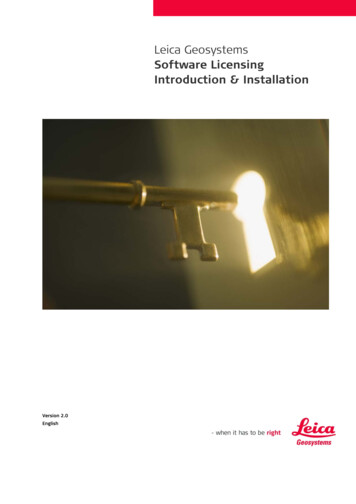



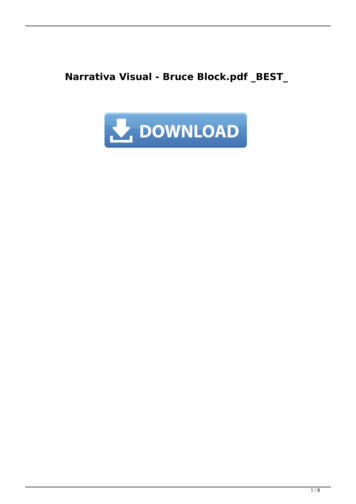
![EXHIBIT 24 [Filed Under Seal] - Washington Post](/img/32/cohen-v-trump-in-support-of-motion-for-class-certification-4.jpg)
